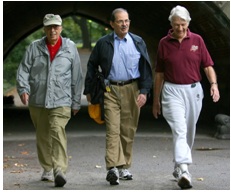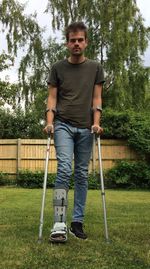Weight bearing
Weight Bearing[edit | edit source]
In orthopaedics weight bearing refers to how much weight the injured limb can take. It is generally used to refer to a percent of the body weight the limb can take as each limb, in a healthy person, takes 100% of the weight during a phase of stance when walking.
After surgery or bone fractures in the lower limb or pelvis is of utmost importance to adhere to the set parameters to aide the best outcome for recovery.[1] The surgeon or treating doctor will set the grades.
Full Weight Bearing (FWB)[edit | edit source]
No restriction to weight-bearing including single leg stance if pertaining to the lower limb. 100% of body weight can be transmitted through the designated limb to be "full weight bearing". FWB is somewhat interchangeable with the term 'weight bear as tolerated' (WBAT) which allows the patient to self-limit their weight bearing up to full weight bear as is tolerable to each individual case, reduced weight bearing usually due to pain and or swelling. An assistive walking aide may be needed if other issues are identified as an issue eg balance or sight affected.
Partial Weight Bearing (PWB)[edit | edit source]
PWB is a broad term and can range from anything greater than non-weight bearing to anything less than full weight bearing. Most of the definitions in literature define partial weight bearing as from 30% to 50% of body weight. PWB may be recommended during fracture rehabilitation, following osteotomies and orthopaedic procedures[2] and is usually accompanied by a percentage figure to further describe the extent of weight bearing recommended. For example, PWB < 50%. An assistive walking aide will be needed, as evaluated by therapist. eg walker, crutches, walking stick.
Touch Weight Bearing (TWB)[edit | edit source]
TWB means the foot or toes may touch the floor (such as to maintain balance), but no weight is taken by the affected limb.Imagine having a potato crisp underfoot that one is not to crush[1]. An assistive walking aide will be needed, as evaluated by therapist eg walker, crutches.
Non Weight Bearing (NWB)[edit | edit source]
NWB status means the patient will not be able to put any weight through the limb and therefore will require eg wheelchair, walker,crutches or other assistive devices to mobilise.
The videoclip below gives a good illustration of each of the above types of WB with assistive devices as needed.
References[edit | edit source]
- ↑ 1.0 1.1 Wikipedia. Weight bearing. Available from: https://en.wikipedia.org/wiki/Weight-bearing (last accessed 4.4.2019)
- ↑ Rubin G, Monder O, Zohar R, Oster A, Konra O, Rozen N. Toe-Touch Weight Bearing: Myth or Reality?. ORTHOPEDICS. 2010; 33
- ↑ Clin skills 2 patient skills. Assistive devices and weight bearing status. Available from: https://www.youtube.com/watch?v=_0Ddj1eUcXU&feature=youtu.be (last accessed 4.4.2019)








